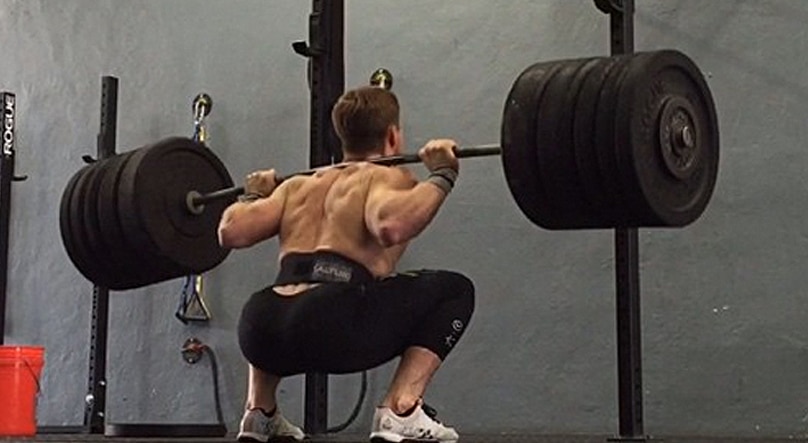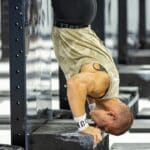The term ‘muscle-bound’ has long been associated with athletes and individuals that have developed large muscle mass through strength training, but in so doing have significantly reduced their ability to move freely through a full range of motion. This is certainly the case for many people in sports and fitness, and yet, we need only look at gymnasts, Olympic Weightlifters, and elite CrossFitters to know that the opposite is true as well. These athletes compete in sports where an imbalance between these two fitness skills would limit their progress and impair their success—and the same applies to you.
How flexibility affects strength
A limited range of motion is going to hold you back from maximizing your strength gains. Think about the mobility you need in your hips and ankles for a typical barbell squat. Then consider the added shoulder and wrist mobility you need for the front and overhead squat. Yet the squat, in all its variations, is renowned as the best compound movement (involving more than one joint) you can possibly perform, especially when it comes to improving overall strength.
Because it does involve so many muscle groups, your body will be triggered to release more testosterone and HGH—two powerful hormones for building muscle mass and strength. And studies have shown that in order to maximize your strength gains, you need to execute full range of motion when squatting in order to have your muscles have greater time under tension. But what if you aren’t mobile enough to break parallel in the back squat, to maintain a front rack position in the front squat, or even hold an empty barbell overhead during an overhead squat? Well, you will inevitably hit strength plateaus that will take some time to break. Needless to say, being flexible enough to put your body in the right positions when moving heavy weight is vital.
If you want to clean, jerk and snatch like an Olympian, first make sure that your body is mobile enough to receive heavy weight—then you will be able to reap the strength benefits of standing up monster weights from the hole. The same concept applies to developing bodyweight strength. One need only look at the body of a gymnast to realize how strong these men and women are—yet they are highly mobile too. Consider this—how many of you struggle with pistols? And, for those who do, do you think it’s because you lack the individual leg strength to perform the movement, or you’re missing the requisite mobility in your hip and ankle to get into the position? I’d wager that for the vast majority of people, the latter is the limiting factor.
But before you start going to yoga 10 times a week and spending countless hours flossing, rolling, banding and performing every stretch known to man, it’s important to remember that there is evidence that too much flexibility can have a negative impact on strength. An increase in flexibility without a corresponding increase in strength can result in joint instability. When someone is hypermobile, their ligaments become loose. This is a problem because ligaments act as the “strapping tape” of our joints by connecting bone to bone. If they become too loose, they have no recoil property. Corrective exercise specialist Brooke Thomas provides the perfect analogy: “Imagine the difference between a rubber band and Silly Putty. Stretch out the elastic and “boing!” back it goes. Stretch out the Silly Putty and you have stringy globbery-goop.”

If the ligaments are too loose, this is where your muscles step up, as part of their job is to determine the appropriate range for a joint (where the bones get to go). “This means if they are functioning in a balanced way, the ligaments do not need to take on a load. And our muscles weave into the bones via tendons, and all of this is living in a sea, inside and out, of fascia [connective tissue that runs throughout the body],” Thomas adds.
Of course, if there isn’t the right balance between muscle strength and flexibility (in this case a lack of strength), the ligaments have to shoulder the load, making them highly susceptible to wear and tear and increasing the risk of serious injuries to the joint. So, we cannot overlook the importance of strength as it relates to flexibility.
How strength affects flexibility
Just as being hypermobile can cause damage to a joint, an increase in strength without a balanced rise in flexibility can result in soft tissue tears, sprains, and postural changes. Now, strength is obviously an important skill that we’re always looking to improve. Being strong allows us to move heavy weight and perform functional tasks outside of the gym.
In addition, many joints in the body require stability so they are able to resist movement from an outside force. For example, ideally, we want the knee joint to be stable so that it doesn’t buckle or twist when we run, squat or jump. One of the best ways of doing that is by increasing the strength of the supporting musculature of that joint—in this case, the quadriceps, the hamstrings and the muscles of the calf. When our joints are stable, we are better able to transfer power throughout the body too. This manifests itself well in the thruster, where we need to generate a lot of force through the joints as we move upwards in order to help get the barbell off the front rack before pressing it overhead.
But wait a second, isn’t squatting one of the best ways to strengthen the supporting musculature of the knee? And didn’t you just write that an athlete needs to have good flexibility in the hips and ankles to be able to perform a squat? Yes, I did—that’s because while some joints of the body require stability (like the knee), others need to be more mobile (such as the hips and ankles). You can emphasize strength training all you want, and the joints that need stability will thank you for it, but if you can’t execute a full range of motion because of how immobile you are where it matters, your strength won’t count for anything. In fact, overly focusing on strength without mobilizing muscle groups can lead to conditions such as anterior pelvic tilt and upper crossed syndrome.
Take someone who spends most of their day sitting at a desk. In this position, their hamstrings are going to become stretched and tight. They then go to the gym and expect to bang out heavy sets of deadlifts. Deadlifts require the hamstrings to be strong, but they also need to be mobile. What happens when you place excessive strain on an already strained muscle group? They tear.
So, it’s obvious that the body in general needs to be supple and strong. A balanced ratio between the two allows an athlete to perform functional movements at full range of motion with heavy weight, while an imbalance in either direction paves the way for injury and postural problems.
Photo courtesy of Greg Cullen/CC BY NC ND 2.0














Awesome article. I never realized how bad my flexibility was until I started CrossFit this past summer. Geez I always thought I had decent form and flexibility compared to all the other guys in my old ‘traditional’ gym. I’ve put my ego aside for the next little while and I’m concentrating on improving my flexibility to hopefully increase my lifts. All the best guys.
Joe